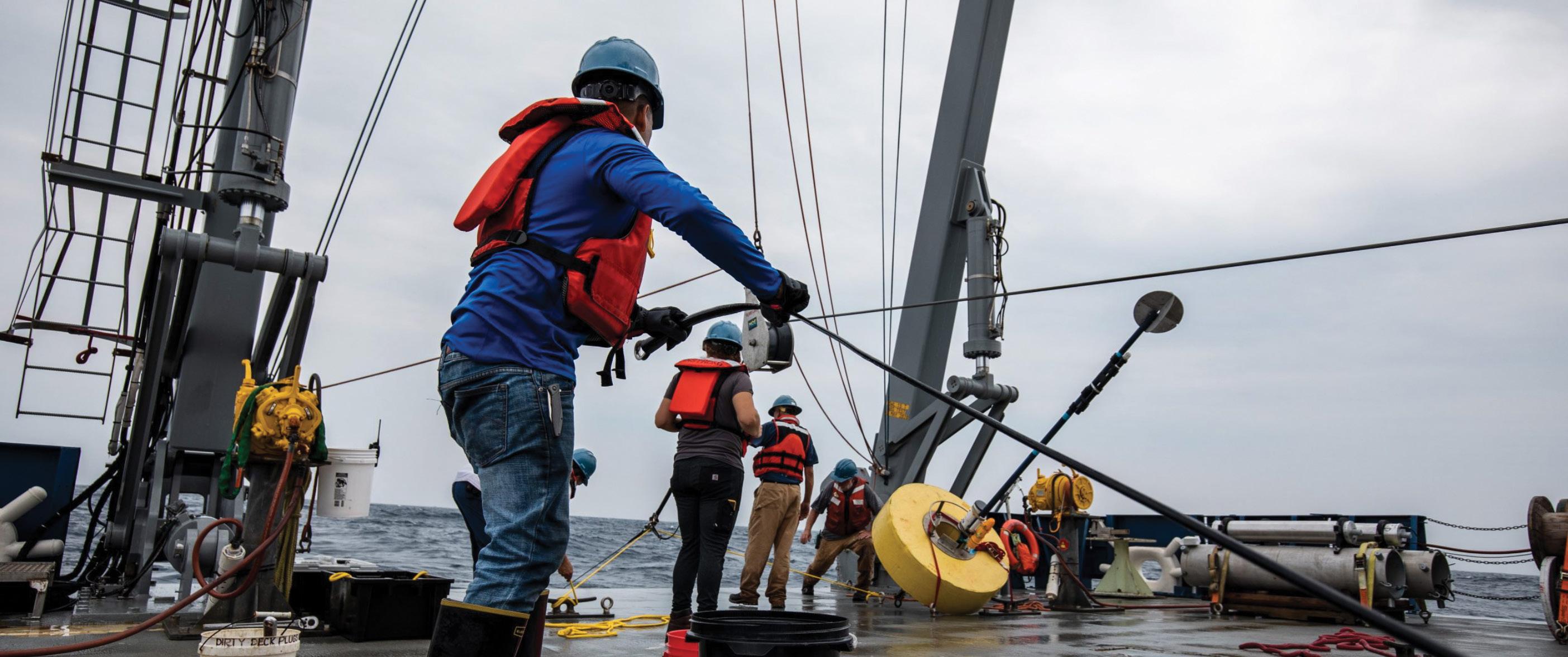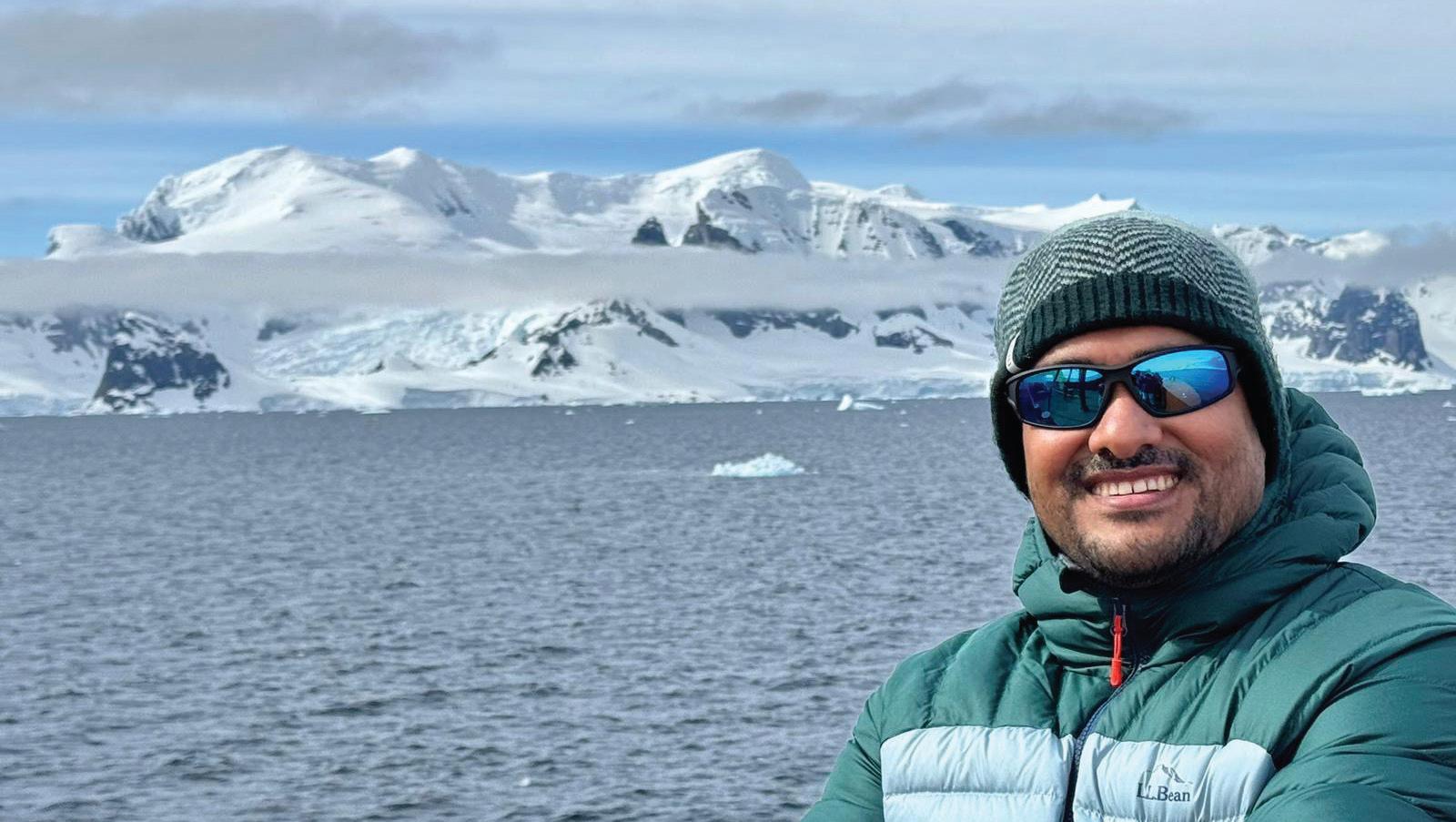
9 minute read
Wokil Bam '12: Searching The Oceans To Fight Climate Change
Wokil Bam was born and raised in landlocked Nepal. He will tell you he lived in the low elevation part of Nepal that’s flat and warm, not the land of highly-elevated mountains that includes the highest peak, Mount Everest, that people picture when they think of his home country.
Wokil chose SMSU for the robust environmental science program as well as the affordable tuition. When he arrived in August 2008, he had never set foot on campus. And like many international students, he experienced snow for the first time at SMSU.
Wokil took his first environmental science class with Dr. Emily Deaver. As a student in the major, she was also his advisor. During his junior year, he added chemistry as his second major. That same year, he decided to take a wetland ecology class with Dr. Deaver and knew immediately he wanted to do wetland science; more specifically, understanding the chemistry of the wetlands and water quality. That drive, and the dream his father had for him to earn at least one graduate degree, motivated him to look at graduate school.
In June 2012, he attended the International Wetland Conference organized by the Society of Wetland Scientists in Orlando, Fla. He did not give a presentation, but received funding from SMSU so he could connect with other scientists. It was there that he met the professor he would work with in graduate school.
As Wokil was finishing his degree in December 2012, Dr. Deaver worked with him on completing his application, teaching statement, research statement, and curriculum vitae. It was quite late when he applied to Louisiana State University (LSU) in October 2012, but was accepted for the master’s degree program starting in January 2013.
When he arrived at LSU, Wokil dove right into his research which focused on understanding the effect of the BP oil spill in 2010 on salt mass wetlands. He studied how the insect population was affected as insects are an early indicator of environmental stress and recovery. After completing his master’s degree, his PhD research shifted from salt mass wetlands to open ocean. That is where he started exploring the marine carbon cycle.
“The ocean absorbs the carbon dioxide (CO2) from the atmosphere and the primary producer, mainly phytoplankton take the CO2 and convert it into organic matter i.e. food. These small microorganisms take the inorganic CO2 from the atmosphere and make it organic matter via photosynthesis which becomes the first part of the ocean’s food chain,” Wokil explained. “The
atmospheric carbon that gets converted into organic matter during photosynthesis, is further transformed into different forms by food web processes and physical mixing, and finally gets transported to the deeper oceans. Only a small fraction of carbon fixed by phytoplankton sinks into the deeper oceans. This process of removing organic matter from surface water to the deep ocean via particle settling is known as the oceanic biological carbon pump (BCP). This carbon cycle, or movement of carbon from the atmosphere through the ocean with the help of marine life, is an important part of the Earth’s climate system.”
He was involved in his PhD research at LSU for about six years, but took a one-year intensive in Monaco, with the International Atomic Energy Agency, an agency of the United Nations. Their work with the marine carbon cycle complemented his doctoral work using radioisotopes to look at the carbon cycle. He then returned to finish his PhD at LSU before moving to Woods Hole Oceanographic Institute (WHOI) as a postdoctoral scholar in June 2021.
“Focusing on the chemistry, I study the carbon cycle, beginning with carbon dioxide in the atmosphere. Then I look at how much CO2 is absorbed by the ocean and taken to the bottom of the ocean. That is the cycle at its simplest because not all the CO2 that the ocean takes in at the surface actually makes it to the bottom,” he said. “The part that makes it to the bottom of the ocean is the most important because it is safely stored there for thousands of years.”
Using research data collected from the oceans around the world, he works to try to predict how the ocean will change with global warming. As the ocean warms, there are places where the productivity of the carbon cycle might be higher or lower.
“Consider all these trees in the land, right? Big trees take more CO2, and small trees take less CO2; it’s the same thing in the ocean. In some places, there is low productivity, but in other areas, there is high productivity. The productivity depends on various factors such as temperature, sunlight, and nutrients.”
“With all ocean zones not being the same, we use data to study trends. Where we see clear water in the middle of the ocean— when you talk about clear blue water, it’s out there and it’s really, really amazing—but there is low productivity. In contrast, the coastal areas where we see high levels of riverine water, there are more phytoplankton and more nutrients cycling the atmospheric CO2,” he continued.
“And when I got to Woods Hole, I’ve jumped into doing this work all over the world. In June 2021, we took a month-long cruise in the North Atlantic, west of the UK. I had another cruise that we started from West Africa to Brazilian waters along the equator. And then last year I was in almost two months from Tahiti to Chile reaching the Southern Ocean and crossing the Pacific Ocean.”
From mid-November 2023 to February 2024, Wokil is participating in a 65-day research trip from Chile to Antarctica and then from there to New Zealand. This is his third research cruise longer than a month, and one of the many cruises he’s
taken since he joined the WHOI. So far, he has spent over 200 days at sea doing research.

“For all the samples we’ll be collecting, we have a complete mobile lab on the vessel. We prepare for an entire year to prepare and determine what we’ll need as far as equipment, instruments, chemicals, technology, machinery, supplies, backups, and batteries for everything,” he said.
“We collect samples from not only the surface but at different depths all the way to the bottom. At some locations, the vessel will stop for three days with the team working around the clock to complete the sample collection and move to the next spot. The team includes about 30 scientists and 10 technicians helping with research, and an entire crew to support the scientists with day-today needs aboard ship for 65 days.”
“What the ocean is doing by its natural functions is helping with the regulation of CO2 concentration atmosphere. It helps to kind of filter some of that out. This research considers questions about the whole climate change issue. The ocean is critical in regulating the atmospheric CO2, which in turn, impacts the climate,” Wokil continued.
Despite all the negative factors weighing on the climate, Wokil still remains optimistic about what can be done to steer change in a positive direction. In his oceanic research community, he’s connected to a network of scientists exploring a variety of solutions.
“So yes, there are many different pieces in the equation, but there is more hope than we think. People focus on planting trees, but because the ocean takes up 75% of the Earth’s surface, there is
untapped potential,” said Wokil. “The oceans are massive and deep; there is much we don’t know about the activity below in the ocean twilight zone.”

“We know we can control the mission now. Our institute has been actively participating in the Conference of Parties (COP) on climate change. There were many people [in the international community] who had no idea that we can take the ocean into consideration when talking about climate change,” Wokil continued. “My research is looking at trying to understand how much carbon is being taken out so we can accurately use those numbers to predict the role of the ocean and to see how we can balance the carbon cycle in general. It’s exciting work to be part of.”
So how does someone coming from a landlocked country like Nepal, with the nearest sea access over 400 miles away, go from Marshall, Minnesota to Baton Rouge, Louisiana to Woods Hole, Massachusetts to become a part-time resident on the world’s oceans?
“I look at all the opportunities. I found that if you do not bind yourself to certain things, then many opportunities come,” Wokil said. “I seek out wherever there is an opportunity and try to take it.”
“I think I would have been lost without the good guidance from the people at SMSU,” Wokil said. “I tried to make the most of every opportunity, like river monitoring, the research conference, and getting involved in so many organizations there so if I had to do it again, I would definitely choose SMSU.”
Since June 2023, Wokil has worked as a postdoctoral investigator, geochemist, radiochemist, and chemical oceanographer in the Department of Marine Chemistry and Geochemistry at the Woods Hole Oceanographic Institution (WHOI) in Woods Hole, Mass. He was a postdoctoral scholar at WHOI from June 2021 to June 2023.
Wokil completed his PhD in Geochemistry/Chemical Oceanography from Louisiana State University in Baton Rouge, La. in May 2021. During his doctoral work, he spent one year with the International Atomic Energy Agency in Monaco. He earned his Master of Science in oceanography and coastal science from LSU in 2015.
Wokil earned his Bachelor of Science in environmental science and chemistry, and a minor in biology, from SMSU in 2012.
For the full story, visit www.SMSU.edu/go/Wokil
Photos show Wokil and team members on the July 2021 mission aboard the research vessel R/V Neil Armstrong in the North Atlantic, west of the United Kingdom. In this short cruise, the Ocean Twilight Zone (OTZ) team installed the first instruments of the new Ocean Twilight Zone Observation Network— a group of heavily-instrumented moorings in the northwest Atlantic. The network monitors the ocean twilight zone over an area of roughly 155,300 square miles, providing scientific data continuously over several years. Photos and mission description provided by Woods Hole Oceanographic Institute. Learn more about the ocean twilight zone: https://twilightzone.whoi.edu. Antarctica photo on pg. 5 courtesy of Wokil Bam.










